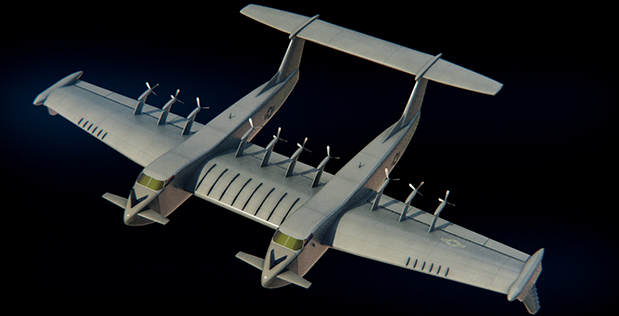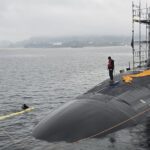The Defense Advanced Research Projects Agency has shut down its three-year effort to build the Liberty Lifter, a heavy-lift seaplane that would skim above waves on a cushion of air. According to industry sources, the agency notified performers on July 12 that work had officially ended after internal reviews found no clear path to an affordable prototype within the 2028 schedule.
Liberty Lifter started in 2022 with bold aims: design, build, float, and fly a cargo aircraft able to move a C-17-class load without land runways. The $98 million program concluded in June, but word of the decision did not surface until last week when defense journals obtained statements from DARPA officials. Defense officials confirm the data package gathered during simulation and materials testing will be transitioned to other offices rather than parked in archive folders.
Planners envisioned a vehicle that combined marine construction with aerospace aerodynamics. The craft would use the Wing-In-Ground effect, flying a few meters above sea level where a pressure “cushion” cuts drag and boosts lift. That concept, first proven by Soviet ekranoplans, promised higher speed than ships and lower cost than jets over trans-oceanic legs.
The notional baseline demonstrator matched a C-130 in footprint and could carry 50,000 pounds. A later eight-engine variant would scale up to the C-17 payload class – about 170,000 pounds – with a planned ferry range above 12,000 nautical miles and a cruise ceiling of 10,000 feet outside ground effect for over-land hops.
Design briefs also called for operations in Sea State 4 during take-off and landing and safe handling in Sea State 5 once afloat. Using shipyard tooling and large composite panels, program engineers believed unit cost could fall below one-third that of comparably sized transports.
General Atomics Aeronautical Systems and Aurora Flight Sciences won competing Phase I contracts in 2024. After a 2023 restructuring, DARPA down-selected Aurora and shifted resources toward risk-reduction builds. That move trimmed schedule margin but removed GA-ASI from the race.
Spending estimates now stand at roughly $98 million, with about two-thirds flowing to materials research and digital engineering. The figure is modest by modern standards yet still large for a concept aircraft that never reached first riveting.
Officials cite three main drivers for the early stop: gaps between maritime construction rules and FAA certification paths; rising test-article costs tied to composite tooling; and shifting Pentagon logistics priorities toward autonomous surface connectors.
Aurora says lessons learned on hydrodynamic modeling, modular wing boxes, and low-cost sensor suites will migrate into other maritime aviation bids. Several Navy staff officers speaking on background echoed that view, noting the Pacific theater still needs runway-independent lift.
Technical milestones reached before closure:
- 310 hours of high-fidelity CFD proving stable cruise at 0.55 Mach five meters above sea level
- Scaled hull drop tests in a wave tank demonstrating safe ditching up to Sea State 5
- Fabrication of a 12-meter wing panel using automated tape laying inside a shipyard bay
Knowledge likely to inform follow-on projects:
- Hybrid composite-aluminum joints tolerant of saltwater immersion
- Fast-connect cargo ramps sized for ISO containers
- Integrated autonomous flight control laws tuned for ground effect
The Wing-In-Ground effect, sometimes called ekranoplan flight, emerges when a wing moves within roughly one chord length of a smooth surface. Airflow under the wing cannot escape downward, so pressure builds and effective lift rises by as much as forty percent while drag falls. Engineers have chased this sweet spot for decades, from Cold-War Soviet prototypes to beach rescue craft. Liberty Lifter aimed to harvest that advantage at strategic scale without locking itself to a single theater. That flexibility marked a clear break from Howard Hughes’s wooden H-4 Hercules – better known as the Spruce Goose – which relied on brute wing span rather than ground effect. Early DARPA modeling showed Liberty Lifter could move aid pallets from Guam to Palau at roughly twenty-five percent less cost per ton-mile than a C-17.
Program momentum shifted late last year when cost curves bent upward. Composite mold tooling, first budgeted at $18 million, climbed to almost double that figure after technical reviews uncovered delamination risks. Parallel modeling showed hull slamming loads in Sea State 5 exceeded margins by eight percent, demanding thicker skins and heavier frames. Those changes threatened to push the empty weight beyond 240,000 pounds – undermining the whole lift-to-weight advantage.
In early July, open-source imagery revealed a Chinese ground-effect prototype parked near the Bohai Gulf. While DARPA made no public link between the sighting and its funding cut, briefings viewed by Defense-Aerospace suggest planners worried that continuing into fabrication could leak trade secrets. The agency chose instead to wrap up its risk work and move on.
Budget pressures provided the final push. The Pacific Deterrence Initiative now favors unmanned barges, vertical-takeoff drones, and pre-positioned fuel bladders. Within that mix, a manned seaplane with eight turboprops looked costly to sustain. The Tactical Technology Office therefore banked the insights and closed the books, echoing its 2024 decision to shutter the Sea Train unmanned surface-craft study.
Commercial operators monitored the project closely. Several Pacific freight lines believed a runway-independent hauler could bypass port congestion during typhoon season, delivering containers straight to protected lagoons. Industry risk analysts who reviewed early cost data projected that a mature fleet might trim cargo-delay insurance payouts by ten percent over a decade.
Logisticians who backed the project remain guardedly hopeful. One Marine Corps officer points to persistent lift gaps across Micronesia and argues that WIG-derived cargo gliders could still serve hub-and-spoke resupply. A Naval Postgraduate School model circulated in June shows a smaller 200-ton ground-effect craft moving pallets between expeditionary “E-Bubbles” for under $3 per pound – half current tilt-rotor costs. Those concepts are likely to feed DARPA’s new Rapid Enabling Capabilities pipeline, with award decisions expected in early 2026.
While Liberty Lifter will never fly, its ripple effects are already visible. Aurora engineers have filed patents covering salt-spray-resistant joints. Naval Sea Systems Command is examining whether the wave-piercing bow fits next-generation connector boats. The Air Force Research Laboratory has expressed interest in control algorithms that kept the big wing level in gusty ground-effect corridors.
Export-controlled data stays under lock for now, yet smaller suppliers see opportunity. A Texas carbon-fiber shop that built the demonstrator’s spar tooling is courting hydrogen airship makers. A Virginia avionics start-up is adapting Liberty Lifter’s distributed sensors to monitor strain on offshore wind vessels. These spin-offs may outlast the original plan.
For allies, the cancellation is both cautionary tale and invitation. Australia’s Defence Science and Technology Group, for example, tracks the findings for its own amphibious connector studies. European research teams exploring civilian ekranoplan ferries also gain. As one allied analyst quipped, “DARPA paid the tuition; now the rest of us can attend the class for free.”
Our analysis shows the decision closes one chapter but opens the door for smaller, distributed-lift ideas that could mature faster under rapid experimentation budgets in the years ahead.
In short, Liberty Lifter’s end reflects ambition more than failure. Programs that probe the boundary between air and sea seldom fly on the first try, yet each step narrows the unknowns. Whether through lighter hulls, smarter autopilots, or hybrid yards, the research completed here will echo through future designs long after these headlines fade.
REFERENCE SOURCES
- https://theaviationist.com/2025/07/11/liberty-lifter-ekranoplan-cancelled/
- https://www.defensenews.com/air/2025/07/09/darpa-ends-cargo-seaplane-program-eyes-new-uses-for-tech/
- https://newatlas.com/military/darpa-axes-giant-liberty-lifter-wing-in-ground-effect-seaplane/
- https://www.darpa.mil/research/programs/liberty-lifter
- https://www.stripes.com/theaters/us/2025-07-11/us-ends-ekranoplan-program-early-18407544.html
- https://www.janes.com/osint-insights/defence-news/sea/darpa-ends-liberty-lifter-wing-in-ground-craft-programme



